


Editors’ Note: John Maxwell will be the keynote speaker at the September 11 edition of our ever-popular CEO Masterclass series, kicking off an exciting new year of sessions and speakers. Join Us >
As global tensions rise and the post-pandemic world continues to grapple with unprecedented challenges, cultural divisions and one of the bitterest, most unpredictable presidential election cycles of our lifetime, the role of CEOs as stewards of our society has never been more critical. In this environment, bestselling author and leadership expert John Maxwell argues that taking the high road in leadership is not just an option—it’s a requirement.
“We’re living in a very ‘me’ culture,” said Maxwell, the author of more than 100 books, including classics including The 21 Irrefutable Laws of Leadership and The 5 Levels of Leadership. “We’ve lost respect for people. We devalue people. It’s a downward spiral…So somebody has to speak up, and then somebody has to show a picture of: what does a high-road leader look like? So what do they look like? Well, high road leaders bring people together.”
Providing models of how—exactly, practically—to do that is the focus of Maxwell’s latest book, High-Road Leadership: Bringing People Together in a World That Divides. In a recent conversation with Chief Executive, ahead of his leading our upcoming CEO Masterclass on September 11, Maxwell made his case for the high-road approach, which emphasizes unity, integrity and a long-term vision as the path forward, emphasizing that leaders who prioritize collective goals over personal or factional interests are the ones who will succeed in today’s environment. And tomorrow’s. The following conversation was edited for length and clarity.
I’ve kind of been leadership sad for a few years now because Covid changed us forever. We still don’t see all the effects of Covid. But most of the things that happened in Covid were not positive in our lives. Most people are less because of Covid instead of more—and then you put that with the dysfunction of the culture that we’re in now.
We have two generations of a dysfunctional culture that’s all about me and “what’s in it for me,” and instant gratification and all the stuff that comes with it. It started in the nineties. With children, when they’re dysfunctional, it doesn’t show up. But when children become adults, it does. So there’s children of the nineties, all of a sudden they’re adults, and now they’re in leadership positions, and they have no business being in leadership positions because they’re totally dysfunctional. They need some help.
I came to the conclusion that this is not going to be a good year for us—how can anything turn out good when you’re led by dysfunctional people? I thought I better write about: what does high road leadership look like? Because we don’t have models for it today.
We’re living in a very “me” culture. We’ve lost respect for people. We devalue people. It’s a downward spiral. So somebody has to speak up, and then somebody has to show a picture of: what does a high-road leader look like? So what do they look like? Well, high road leaders bring people together. They don’t divide people. Low road leaders divide people. If you’re dividing people, you’re not looking out for common cause or the big picture, you’re looking out for your cause. Why would you divide people? Unless you wanted to win an election more than you wanted to help a country.
It’s called silos in a company. “This is our silo. This is who we are. We really don’t really care what they’re doing. It’s all about us.” High-road leaders value all people. They value all people because they know that diversity brings tremendous balance. There’s no such thing as a balanced leader, but there is such a thing as a balanced team. You don’t get balanced in the singular, you only get balanced in the plural.
Well, remember dysfunctional people never see the whole, it’s not possible. They see their perspective. The reason they’re dysfunctional is they don’t see the perspective of others. It is kind of like self-awareness. You know, when a person says they’re self-aware, I want to walk into their life and say, “If you are self-aware, which is possible, you’re only self-aware because you have people around you who’ve made you aware.”
Self-awareness comes from a leader being humble enough and teachable enough to ask the people around him or her to make them aware. I’m constantly asking my people after every time we gather, I look at all of them and I ask, “What am I missing?” People say, “Why do you ask what you’re missing?” Because I’m missing something. I know I am. Or I ask them: “What’s it like to be on the other side of me? Talk to me about that. Because I’m not on the other side of me. I’m me. And so therefore, I don’t know what it’s like, but you do. Give me insight. Help me.”
I was speaking for Johnson & Johnson a few years ago. I was in a session on vulnerability and humility. I said, “One of the things you really need to do is you need to go back to your place of work, and you need to sit down with your people and share with them the areas that you’re weak in, that you’re not any good in. You need to share your weaknesses with them.”
Well, you could feel that whole room blow up real quick. So I said, “Let’s take a break. I thought they needed some fresh air.” I’m signing books and this [divisional] CEO is standing beside me, and I looked up and said, “Can I help you?”
“Well,” he said, “you’re not helping.”
He said, “You said something last session that’s just wrong and I think I need to confront you on it.” I said, “Sure.” He said, “What’s this about letting people see your weaknesses? That’s not how leaders lead. You don’t lead out of weakness. You lead out of strengths.”
He gave me this pep talk on strengths, you know, the kind any insecure person would give you. I just quietly listened to him and when he got done, I said, “I got it. What you said makes a lot of sense to me, but you’re missing something. You assume your people don’t know your weaknesses. That’s a huge miss. They talk about them every day. In fact, they’re worried. They’re looking around, asking each other, ‘Who’s going to tell him.’”
This is what I’m talking about. I don’t know my weaknesses. The only way I’m going to be self-aware is to say “You’re going to have to help me. You’re going to have to talk to me. I need to listen to you.”
That has to come from the top, because people that don’t have that permission won’t usually be open enough to share it. Secrets are kept which are destroying the best of what leaders could really become.
You only get buy-in when you’ve bought in. I tell leaders you don’t get buy in by title or position. “I’m the CEO, I want you all to get this book, I want you all to discuss this book.” I have seven companies, and one of them is a leadership trading company, and we have several leadership training courses.
What we’ve discovered is very simple: None of them work if the top people don’t get involved. In all of our training we vet the leaders. We say, “We’re only going to come in and do leadership training in your company if you attend. It’s okay if you don’t attend, but go find somebody else to do your leadership training.”
It isn’t the program that you produce that makes it successful, it’s the people who attend. All CEOs have to understand is that the greatest words of leadership advice they can give anybody are: follow me.
Awareness is always the first step. It’s the first step of anything that’s going to be improved. You can’t fix what you don’t know. Leaders are responsible for awareness because leaders see more than others see, and they see before others see. I’m responsible as a leader to help people see what’s happening, what’s going to happen and give them a bigger picture.
That’s huge. That’s really huge. That’s what the book’s all about. If you don’t see the picture, you don’t take action. And there’s no success without action–and there never has been.




0

1:00 - 5:00 pm
Over 70% of Executives Surveyed Agree: Many Strategic Planning Efforts Lack Systematic Approach Tips for Enhancing Your Strategic Planning Process
Executives expressed frustration with their current strategic planning process. Issues include:
Steve Rutan and Denise Harrison have put together an afternoon workshop that will provide the tools you need to address these concerns. They have worked with hundreds of executives to develop a systematic approach that will enable your team to make better decisions during strategic planning. Steve and Denise will walk you through exercises for prioritizing your lists and steps that will reset and reinvigorate your process. This will be a hands-on workshop that will enable you to think about your business as you use the tools that are being presented. If you are ready for a Strategic Planning tune-up, select this workshop in your registration form. The additional fee of $695 will be added to your total.

2:00 - 5:00 pm
Female leaders face the same issues all leaders do, but they often face additional challenges too. In this peer session, we will facilitate a discussion of best practices and how to overcome common barriers to help women leaders be more effective within and outside their organizations.
Limited space available.

10:30 - 5:00 pm
General’s Retreat at Hermitage Golf Course
Sponsored by UBS
General’s Retreat, built in 1986 with architect Gary Roger Baird, has been voted the “Best Golf Course in Nashville” and is a “must play” when visiting the Nashville, Tennessee area. With the beautiful setting along the Cumberland River, golfers of all capabilities will thoroughly enjoy the golf, scenery and hospitality.
The golf outing fee includes transportation to and from the hotel, greens/cart fees, use of practice facilities, and boxed lunch. The bus will leave the hotel at 10:30 am for a noon shotgun start and return to the hotel after the cocktail reception following the completion of the round.